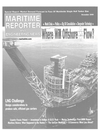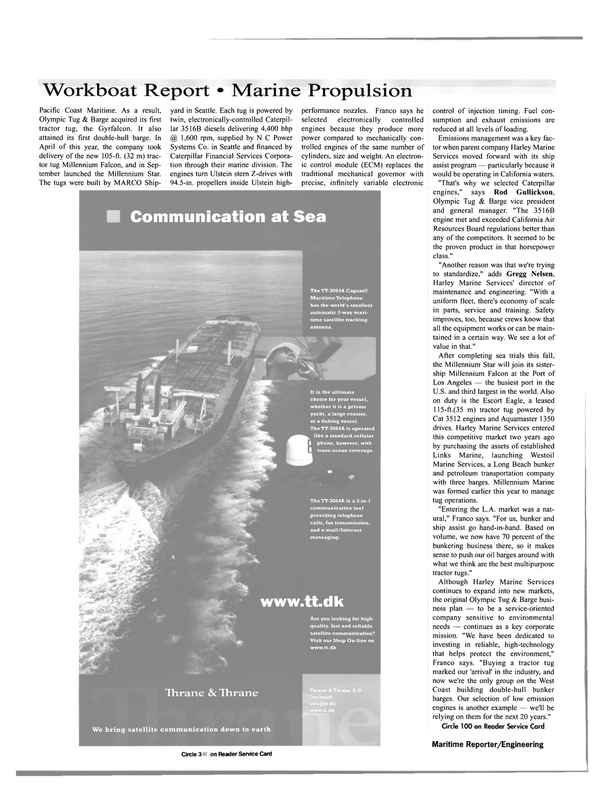
MTU Presents New 8000 Series
Seeking to vastly expand its propulsion range and the types of vessels, which it serves, MTU has introduced a new group of engines dubbed the 8000 series.
The first engine of the Series 8000 with a cylinder output of 410 kW and a nominal speed of 1,150 rpm will be available as of April 2001.
Presented in Hamburg in conjunction with SMM 2000, the new engine is considered an essential part of a product offensive, which was launched in 1996 with the introduction of the Series 2000 and 4000 engines.
Initially, the engines are being touted as appropriate for high-speed ferries, yachts and naval vessels, all current strongholds for the current MTU stable.
However, the 8000 concept goes far beyond a 20 cylinder version of these applications. Accordingly, MTU is planning to make available to the market 16V and 12V versions and, due to the flexible engine concept of the 8000 series, in-line engines and heavy-fuel engines, allowing the company the capability to provide a range of products for the large segment of commercial ships.
The 8000 features common-rail injection, a technology that was originally deployed in the MTU 4000 series and allows the independent determination of all injection parameters, resulting in reduced fuel consumption and emissions.
Another characteristic of the 8000 series is the sequential turbo charging, which is an optional feature. The technology is designed to considerably help supercharged engines to achieve a wide performance map, thus good acceleration while keeping fuel consumption and smoke levels low. With sequential turbo charging, individual exhaust turbochargers can be switched on and off during operation, depending on the engine's power demand.
All engines of the Series 8000 are controlled and monitored by the electronic engine management system MDEC.
The system is designed to optimize all engine functions, and the engine can be included in an overall controlling and monitoring concept of the entire propulsion system and other areas of the ship.
The reported drive in developing the 8000 was an overall reduction of life cycle costs through the reduction of fuel consumption and maintenance costs. For example, when deployed in a fast com- mercial ship application, the fuel consumed by the 20V 8000 lies, over a wide operating range, below 195 g/kWh. At its best performance, it remains below 190 g/kWh, while always keeping within IMO limits for NOx.
On the maintenance side, intervals between the engine main overhauls are set at 24,000 hours for fast commercial vessels. When maintenance is needed, time spent working on the powerplant is minimized by the fact that all components subject to maintenance routines have been placed into a so-called service block at the free end of the engine.
Circle 91 on Reader Service Card
Read MTU Presents New 8000 Series in Pdf, Flash or Html5 edition of November 2000 Maritime Reporter
Other stories from November 2000 issue
Content
- Cornering the ULCC Niche page: 8
- The Future Of E-Commerce: Will The Maritime Industry Be Left Behind? page: 12
- Shipowners, Charterers Launch New Internet-Based Shipping Exchange page: 15
- Shipbuilders Complain To EU About S. Korean Subsidies page: 16
- Robert Allan Lands Fireboat Design Contract page: 16
- Tribon Solutions Signs Contract With DHI page: 18
- FBMA Babcock Secures TriCat Order page: 19
- Keppel Shipyard Is Awarded Jumboization Contract page: 19
- World Single Hull Tanker Phase-Out Is Coming page: 22
- INTERTANKO Calls For "Reasoned Solution" In Wake Of Single Hull Phase Out page: 23
- Exxon Mobil Appeal Rejected page: 24
- IMO Forum To Address High-Density Oil Spills page: 24
- Greek Ferry Disaster Will Result In Safety Enhancements page: 26
- New Safety Technology Unveiled page: 26
- Oil Instability, consolidation Muddy Offshore E&P Picture page: 27
- World Floater Market Is Stable page: 29
- Olympic Engine Selection Evokes Thoughts Of "Green" page: 31
- Volvo Penta Offers Larger Engine Range page: 33
- MTU Presents New 8000 Series page: 34
- ZF Fortifies Product Line, Business Plan page: 36
- ABS Innovates For Petrobras Project page: 40
- Environmentally Sound, Commercial Efficient Wastewater Treatment page: 45
- Ansell Jones Uniquely Serves Offshore Market page: 48
- Deepwater Business Prospects Ripe page: 49
- W&D Completes Moran Series page: 50
- Atlantic Marine Awarded Additional ATB Contract page: 50
- Klyne Tugs Orders AHTS From China page: 52
- What Happened to the Hunley: ? page: 58
- Companies Bond Together To Form American Salvage Association page: 64
- Gas Ship Design Challenges page: 66
- McAlear Named CEO Of Kvaerner Philadelphia Shipyard page: 73
- Historical Keel Laying Occurs At Ingalls page: 74
- Polish Shipbuilding Industry Consolidates, While Competition Continues To Boom page: 75
- PRS Seeks Strong Comeback, Stresses Safety page: 80
- New Marine Technology: The Hallmark of SMM 2000 page: 81
- The "Wired" Ship page: 88
- Flat Screens, Big Images page: 88
- Wartsila Unveils Plans For The Future page: 89
- Wartsila To Provide Power On Unique Icebreaking Tankers page: 90
- Kvaerner Delivers Explorer of the Seas page: 94
- The SatCom Shakeout page: 95


